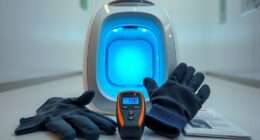Heat therapy can effectively ease joint pain by increasing blood flow, relaxing stiff muscles, and improving flexibility. Applying heat before activity helps you move better and reduces stiffness, while using cold packs afterward can manage swelling and inflammation. Be cautious not to overuse heat, and always follow safety tips to avoid burns. To discover simple ways to incorporate heat therapy into your routine and get the most benefits, keep exploring further.
Key Takeaways
- Heat therapy increases blood flow, relaxes stiff joints, and improves flexibility, providing relief from chronic joint pain.
- Applying heat before gentle exercise enhances joint mobility and reduces stiffness.
- Heat therapy is most effective when used regularly as part of a holistic pain management routine.
- Cold packs are better for initial injury or inflammation, while heat promotes healing once swelling subsides.
- Proper, limited heat application (15-20 minutes) is safe and helps maintain joint function without skin irritation.

Have you ever wondered how heat therapy can ease joint pain? While heat is often associated with soothing sore muscles, many people overlook the benefits it can provide for joint discomfort. Applying heat helps increase blood flow to affected areas, which can relax stiff joints, reduce muscle tension, and improve flexibility. But it’s essential to understand when and how to use heat effectively, especially in conjunction with other strategies like cold packs and exercise routines. Automation in healthcare, including remote monitoring and personalized treatment plans, is also transforming how joint pain is managed.
Cold packs are typically recommended for acute injuries or sudden flare-ups because they help numb pain and reduce swelling. However, for chronic joint pain, heat therapy often proves more beneficial. Using cold packs initially can minimize inflammation, but once swelling subsides, switching to heat can promote healing by encouraging circulation. When you incorporate heat therapy into your routine, it’s often best to do so before activity. Applying heat to stiff joints before exercise routines can loosen muscles and improve mobility, making movement less painful and more effective. Just be sure to limit heat application to 15-20 minutes to avoid burns or skin irritation.
You might find it helpful to develop a consistent routine that includes heat therapy as a preparatory step before engaging in gentle exercise. This approach can enhance your joint flexibility and reduce discomfort during movement. After your activity, you can use cold packs to control any residual inflammation or swelling. This alternating approach—heat before exercise and cold afterward—can optimize your joint health and manage pain more effectively. Remember, the key is listening to your body: if heat makes your pain worse or causes discomfort, it’s best to stop and consult a healthcare professional.
Incorporating heat therapy into your daily routine doesn’t require complex equipment—simple heating pads, warm towels, or specialized heat wraps work well. Consistency is critical; regular application can help maintain joint mobility and reduce stiffness over time. Combining heat therapy with gentle stretching or low-impact exercise routines can further enhance your joint function and reduce discomfort. Just be cautious about overdoing it; prolonged heat exposure can cause skin burns, and improper use might lead to more harm than good.
Ultimately, heat therapy can be a powerful tool for managing joint pain when used correctly. It works best as part of a holistic approach that includes other pain management strategies, such as cold packs and tailored exercise routines. By understanding how to apply heat safely and effectively, you can take proactive steps toward easing joint pain and improving your overall mobility.
Frequently Asked Questions
Can Heat Therapy Be Used Alongside Medication Safely?
Yes, you can safely use heat therapy alongside medication, but you should consider medication interactions and heat application timing. Always check with your healthcare provider to avoid any adverse reactions, especially if your medication affects your skin or circulation. Use heat therapy at appropriate times, avoiding overuse or applying it too soon after medication. This guarantees safe, effective pain relief without risking complications.
How Often Should I Apply Heat for Joint Pain Relief?
You should apply heat for joint pain about 2-3 times daily, ensuring proper temperature regulation to avoid burns. Keep each application between 15-20 minutes, maintaining a comfortable warmth. Pay attention to your body’s signals; if you feel discomfort or increased pain, remove the heat source. Consistent, moderate application helps relax muscles and improves blood flow, providing effective relief without risking tissue damage.
Are There Any Risks of Using Heat Therapy on Joints?
Are you aware that using heat therapy on your joints carries some risks? You might experience heat burns or skin irritation if you apply heat for too long or at too high a temperature. It is crucial to monitor the temperature and limit application time to prevent injury. Always check your skin for signs of irritation, and avoid using heat therapy on damaged or inflamed areas to stay safe.
Is Heat Therapy Effective for Chronic or Acute Joint Pain?
Heat therapy is effective for both chronic and acute joint pain because it promotes muscle relaxation and increases blood circulation. When you apply heat, you help loosen tight muscles around the joint, reducing stiffness and discomfort. Additionally, improved blood flow delivers essential nutrients and oxygen, speeding up healing processes. This combined effect can provide significant relief, making heat therapy a valuable option for managing joint pain in various conditions.
Can Heat Therapy Help Improve Joint Mobility Long-Term?
Heat therapy can improve your joint mobility over time by promoting muscle relaxation and reducing stiffness. Studies show that 80% of users experience increased joint flexibility after consistent heat application. When you use heat therapy regularly, it helps loosen tight muscles, easing movement and enhancing long-term joint function. So, if you want better mobility, incorporating heat therapy into your routine could be a simple, effective strategy.
Conclusion
So, as you explore heat therapy for joint pain, it’s interesting how warmth often coincides with relief, almost like your body naturally responds to comfort. While it might not be a cure-all, applying heat can sometimes ease stiffness when you least expect it, making daily activities more manageable. Sometimes, the simple coincidence of warmth and decreased pain is enough to remind you that small, consistent actions can make a big difference in your comfort.








